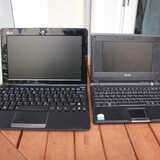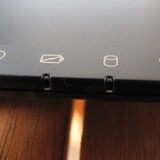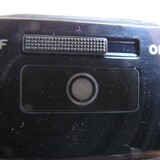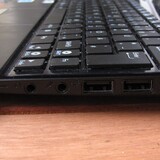Asus EeePC 1015PE
Since a few days I have a new netbook which will replace my old EeePC 4G. I again decided to buy a model from Asus' EeePC line. The Asus EeePC 1015PE costs around 350€ currently and comes with a 1.66Ghz Intel® Atom™ N450 CPU, 250GB HDD, 1GB RAM and a matte non-glare 10.1“ display.
Asus sells these netbooks with various different cases. Eg. there are two black models: one with a shiny finish and one in matte black. I got the latter one1). Unfortunately, even though it's matte, you still see finger prints on it easily.
It weights 1253g including the battery (my old 4G brought 929g to the scale). The keyboard is quite nice except for the right shift key position which is as messed up as on all Asus netbooks.
Otherwise I'm very happy with it so far. I haven't really tested the battery runtime, which Asus claims to be up to 13 hours, but about 8 hours seem to be easily achievable. This is finally a laptop where I will no longer need to have an eye on the battery meter anymore. Perfect for long travels by train. The dualcore N450 CPU is more than enough power for what I do on a laptop. I might upgrade the RAM to the maximum of 2GB though.
Ubuntu Netbook Edition
I decided to try a netbook optimized distribution instead of my trusted Arch Linux on this machine and went with the Ubuntu Netbook Edition. I have to admit I'm really impressed by this distribution (I never used Ubuntu myself before). Everything worked out of the box, including WiFi and the camera.
Of course I still had to tweak a few things.
Multitouch Touchpad
When I tried to configure the touchpad I noticed that not everything did work as I thought. The kernel had detected the touchpad as a simple Logitech PS/2 mouse. Googling a bit I found that I needed two things: a newer kernel and a parameter to be passed to the psmouse kernel module.
The new kernel can be installed without compiling it your self by following these instructions:
wget http://kernel.ubuntu.com/~kernel-ppa/mainline/v2.6.34-lucid/linux-headers-2.6.34-020634_2.6.34-020634_all.deb wget http://kernel.ubuntu.com/~kernel-ppa/mainline/v2.6.34-lucid/linux-headers-2.6.34-020634-generic_2.6.34-020634_i386.deb wget http://kernel.ubuntu.com/~kernel-ppa/mainline/v2.6.34-lucid/linux-image-2.6.34-020634-generic_2.6.34-020634_i386.deb sudo dpkg -i linux-headers-2.6.34-020634_2.6.34-020634_all.deb sudo dpkg -i linux-headers-2.6.34-020634-generic_2.6.34-020634_i386.deb sudo dpkg -i linux-image-2.6.34-020634-generic_2.6.34-020634_i386.deb
The option is passed to the module by creating a file /etc/modprobe.d/psmouse.conf with the following content:
- /etc/modprobe.d/psmouse.conf
options psmouse force_elantech=1
Now that the touchpad was correctly recognized, I noticed another problem. The Eee PC 1015 comes with a multitouch capable touchpad. This means you can execute different actions depending on the numbers of fingers you use. You can tap with two fingers to execute a right or middle click for example. Since there's a dedicated hardware button for left and right clicks, putting middle click on the two finger tap is the most sensible option there. Too bad that the Gnome developers thought otherwise and hardcoded two finger taps to right click 
Luckily Yuri Khan provides a patched version of the Gnome Settings Daemon:
wget https://launchpad.net/~yurivkhan/+archive/ppa/+files/gnome-settings-daemon_2.30.0-0ubuntu7~ppa1~lucid1_i386.deb dpkg -i gnome-settings-daemon_2.30.0-0ubuntu7~ppa1~lucid1_i386.deb
After installing, login again and reconfigure the tap events accordingly in gconf:
gconftool --type int -s /desktop/gnome/peripherals/touchpad/tap_button_2 2 gconftool --type int -s /desktop/gnome/peripherals/touchpad/tap_button_3 3
Powersaving
Even though the 1015 has impressive battery life it's always worth to tune power saving settings a bit.
First I “unlocked” the main gnome panel by following the instructions at Community Documentation. Then I installed the “CPU Frequency Scaling Monitor” from the software center, to be able to easily switch the powersaving governor.
Next I decided to switch off bluetooth by default by issuing rfkill block bluetooth on bootup. This way it can be easily enabled through the Bluetooth Manager when needed.
I also installed and ran powertop. I put everything it suggested into /etc/rc.local. I'm not sure if it really helps anything but it doesn't seem to hurt either:
- /etc/rc.local
#!/bin/sh -e # # rc.local # # This script is executed at the end of each multiuser runlevel. # Make sure that the script will "exit 0" on success or any other # value on error. # # In order to enable or disable this script just change the execution # bits. # # By default this script does nothing. # disable Bluetooth by default /sbin/rfkill block bluetooth ## PowerTop suggestions: # Enable SATA ALPM link power management via: echo min_power > /sys/class/scsi_host/host0/link_power_management_policy # Enable HD audio powersave mode by executing the following command: echo 1 > /sys/module/snd_hda_intel/parameters/power_save # increase the VM dirty writeback time from 0.00 to 15 seconds with: echo 1500 > /proc/sys/vm/dirty_writeback_centisecs # Enable wireless power saving mode by executing the following command: /sbin/iwconfig wlan0 power timeout 500ms exit 0
Don't forget to set the correct permissions:
#> chmod 755 /etc/rc.local
I also modified my fstab and set the noatime options for my file systems and moved /tmp and /var/tmp to a tmpfs.
That's it so far. I really like this little machine and the Ubuntu system so far. If you have any Ubuntu or Netbooks tips I should look into, please let me know in the comments.





